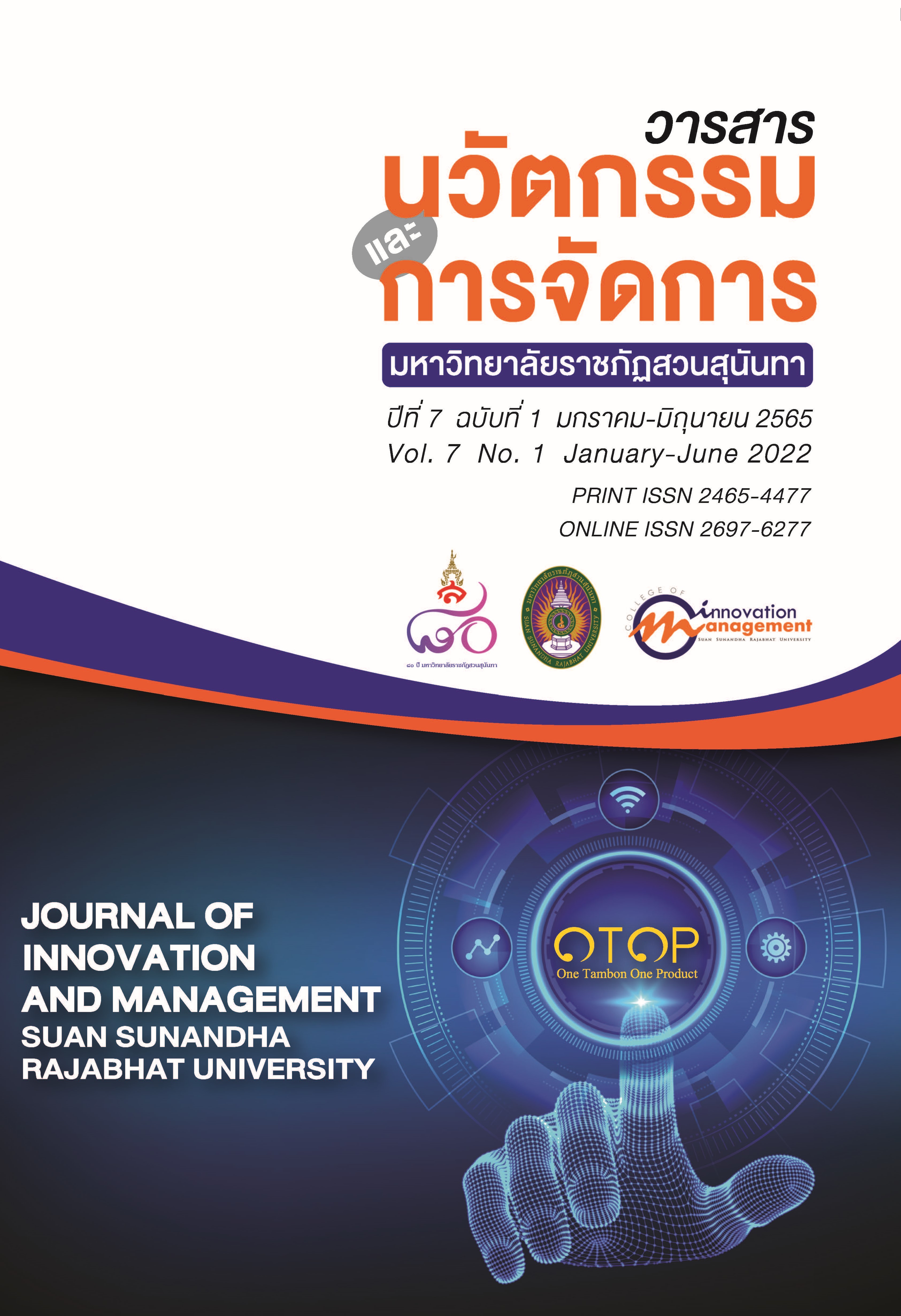Antecedents and Consequences of Frontline Employee Emotional Labor When Dealing with Foreign Customer
Keywords:
Emotional Labor, Emotive Effort, Innovative Work Behavior, Emotional Exhaustion, Effective Cultural Flexibility IntelligenceAbstract
The purpose of this research was to examine the causal factors and the outcomes of emotive effort that leads to frontline employees’ action in accordance with the specific situation. The samples consisted of 332 hotel frontline employees in the central region who have experience in providing services to foreign customers. Data was collected by using questionnaires and was analyzed by percentage, mean, standard deviation and structural equation modelling. The results showed that most of the respondents were female. In the age, 21-30 is age ranges of the most respondents. Most of them hold bachelor’s degree. The hypothesis testing results identified the causal factors as display rule and effective cultural flexibility intelligence had a significantly positive effect on the emotive effort, whereas job autonomy had a statically insignificant positive effect on emotive effort. Moreover, the emotive effort was found to have a positive impact on emotional exhaustion and innovative work behavior of frontline employees.
References
Amabile, T. M. and Pratt, M. G. (2016). The dynamic componential model of creativity and innovation in organizations: making progress, making meaning. Research in Organizational Behavior, 36, 157–183.
Ang, S., Van Dyne, L., Koh, C., Ng, K.Y., Templer, K.J., Tay, C. and Chandrasekar, N.A. (2007). Cultural intelligence: its measurement and effects on cultural judgment and decision making, cultural adaptation and task performance. Management and Organization Review, 3, 335-371.
Brotheridge, C. M., and Grandey, A. A. (2002). Emotional Labor and Burnout: Comparing Two Perspectives of “People Work”. Journal of Vocational Behavior, 60(1), 17-39.
Bücker, J., Furrer, O. and Lin, Y. (2015), Measuring cultural intelligence: a new test of the CQ scale. International Journal of Cross-Cultural Management, 15(3), 259-284.
Byrne, B. M. (2010). Structural Equation Modeling with AMOS: Basic Concepts, Applications, and Programming. 2nd ed. New York: Taylor & Frank Group.
Chen, C. F., and Kao, Y. L. (2012). Investigating the antecedents and consequences of burnout and isolation among flight attendants. Tourism Management, 33, 868-874.
Chu, K. H. L., and Murrmann, S.K. (2006). Development and validation of the hospitality emotional labor scale. Tourism Management, 27(6), 1181-1191. doi: https://doi.org/10.1016/j.tourman.2005.12.011.
Diefendorff, J.M., Croyle, M.H., and Gosserand, R.H. (2005). The dimensionality and antecedents of emotional labor strategies. Journal of Vocational Behavior, 66, 339-357.
Ekman, P. (1973). Cross-Cultural Studies of Facial Expression. In P. Ekman (Ed.), Darwin and Facial Expression: A Century of Research in Review (pp. 169-222). New York: Academic Press.
Fredrickson, B. L. (2001). The role of positive emotions in positive psychology: The broaden-and-build theory of positive emotions. American Psychologist, 56(3), 218–226.
Grandey, A. A., Fisk, G. M., Mattila, A. S., Jansen, K. J., and Sideman, L. A. (2005) Is “service with a smile” enough? Authenticity of positive displays during service encounters. Organizational Behavior and Human Decision Processes, 96(1), 38–55.
Hackman, J. R. and Oldham, G. R. (1975). Development of the job diagnostic survey. Journal of Applied Psychology, 60(2), 159-170.
Hair, J. F., Black, W. C., Babin, B. J., and Anderson, R. E. (2010). Multivariate Data Analysis. 7th ed. New Jersey: Prentice Hall.
Hill, N. S., Zhang, H., Zhang, X., and Ziwei, Y. (2020). The Impact of Surface and Deep Acting on Employee Creativity. Creativity Research Journal, 32(3), 287-298. doi:10.1080/10400419.2020.1821564
Hobfoll, S. (1989). Conservation of Resources. A New attempt at conceptualizing stress. The American Psychologist, 44(3), 513–524.
Hwang, W. J., and Park, E. H. (2022). Developing a structural equation model from Grandey's emotional regulation model to measure nurses' emotional labor, job satisfaction, and job performance. Applied Nursing Research, 64, 151557. doi: https://doi.org/10.1016/j.apnr.2021.151557
Iplik, F. N., Topsakal, Y., and Iplik, E. (2014). The Effects of Emotional Labor on Job Attitudes of Hotel Employees: Mediating and Moderating Roles of Social Support and Job Autonomy. International Review of Management and Marketing, 4(3), 175-186.
Janssen, A. (2000). Job demands, perceptions of effort-reward fairness and innovative work behaviour. Journal of Occupational and Organizational Psychology, 73(3), 287-302.
Kim, S., and Wang, J. (2018). The Role of Job Demands⁻Resources (JDR) between Service Workers' Emotional Labor and Burnout: New Directions for Labor Policy at Local Government. International journal of environmental research and public health, 15(12), 2894. doi: 10.3390/ijerph15122894
Maslach, C., and Jackson, S. E. (1981). The measurement of experienced burnout. Journal of Occupational Behavior, 2(2), 99-113.
Peng, K. Z., Wong, C. S., and Che, H. S. (2010). The missing link between emotional demands and exhaustion. Journal of Managerial Psychology, 25(7), 777-798.
Phuoc, N. H., Hau, L. N., and Thuy, P. N. (2021). The dual outcomes of frontliner’s autonomous motivation and deep acting in service co-creation: a dyadic approach. Service Business, 1-28. doi: 10.1007/s11628-021-00473-6.
Xu, S., Martinez, L. R., and Lv, Q. (2017). Communication is Key: The Interaction of Emotional Labor Strategies on Hotel Supervisors' Turnover Intentions in China. Tourism Analysis, 22(2), 125-137.
Yikilmaz, I., Tasdemir, D. D., and Cekmecelioglu, H. G. (2021). The Assessment of the Intermediation Role of Emotional Labor Dimensions in The Relationship between Cultural Intelligence and Individual Work Performance. Business and Economics Research Journal, 12(1), 157-172.
Downloads
Published
How to Cite
Issue
Section
License
Copyright (c) 2022 Journal of Innovation and Management

This work is licensed under a Creative Commons Attribution-NonCommercial-NoDerivatives 4.0 International License.
See Publication Ethics https://so03.tci-thaijo.org/index.php/journalcim/Ethics






